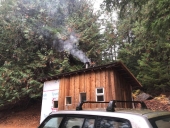
 5
5




 2
2




best regards, Byron
 1
1




best regards, Byron
 1
1




 3
3




best regards, Byron
 1
1








 4
4




 2
2




 Ultimately I want smaller, but she wants square footage for the kiddos, so I'm sure I'll be the one compromising... I plan on using the RMH for absolutely everything that I can, cooking, heating, hot water, baking, etc etc. That's why I want to build a simple J-Tube style at home in Kenai first, so that I can experiment before planning the big one out north. I will have back-up cooking sources, propane fueled, for simple cooking purposes but my ultimate goal is to be free of the need for fossil fuels. One other idea I have is to have a standard secondary air wood stove in the home for a "just in case scenario." Something that can provide quick heat if there are issues with the RMH. We get a lot of good earthquakes on a regular basis so I'd rather not leave my heat source to just one unit, especially considering the fact that it'll be made out of the very stuff that isn't very earthquake friendly.
Ultimately I want smaller, but she wants square footage for the kiddos, so I'm sure I'll be the one compromising... I plan on using the RMH for absolutely everything that I can, cooking, heating, hot water, baking, etc etc. That's why I want to build a simple J-Tube style at home in Kenai first, so that I can experiment before planning the big one out north. I will have back-up cooking sources, propane fueled, for simple cooking purposes but my ultimate goal is to be free of the need for fossil fuels. One other idea I have is to have a standard secondary air wood stove in the home for a "just in case scenario." Something that can provide quick heat if there are issues with the RMH. We get a lot of good earthquakes on a regular basis so I'd rather not leave my heat source to just one unit, especially considering the fact that it'll be made out of the very stuff that isn't very earthquake friendly.
 1
1




 3
3





 10
10




For all your Montana Masonry Heater parts (also known as) Rocket Mass heater parts.
Visit me at
dragontechrmh.com Once you go brick you will never go back!
 1
1









best regards, Byron
 3
3








 3
3




 3
3








 3
3




 2
2




 1
1




 2
2





|
if you think brussel sprouts are yummy, you should try any other food. And this tiny ad:
The new purple deck of permaculture playing cards
https://www.kickstarter.com/projects/paulwheaton/garden-cards
|








